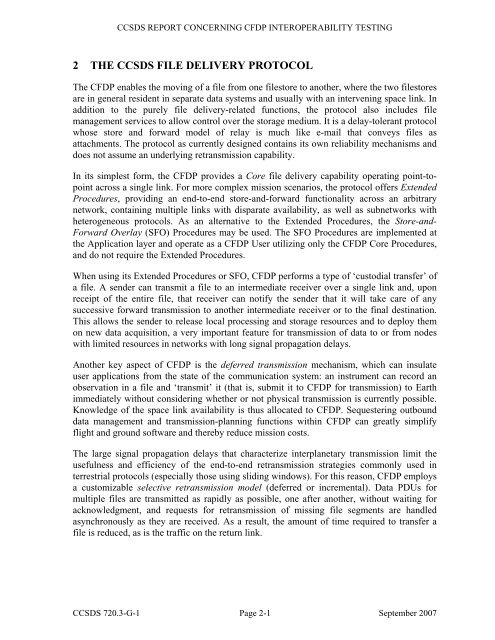CCSDS File Delivery Protocol (CFDP)âPart 3: Interoperability ...
CCSDS File Delivery Protocol (CFDP)âPart 3: Interoperability ...
CCSDS File Delivery Protocol (CFDP)âPart 3: Interoperability ...
You also want an ePaper? Increase the reach of your titles
YUMPU automatically turns print PDFs into web optimized ePapers that Google loves.
<strong>CCSDS</strong> REPORT CONCERNING <strong>CFDP</strong> INTEROPERABILITY TESTING<br />
2 THE <strong>CCSDS</strong> FILE DELIVERY PROTOCOL<br />
The <strong>CFDP</strong> enables the moving of a file from one filestore to another, where the two filestores<br />
are in general resident in separate data systems and usually with an intervening space link. In<br />
addition to the purely file delivery-related functions, the protocol also includes file<br />
management services to allow control over the storage medium. It is a delay-tolerant protocol<br />
whose store and forward model of relay is much like e-mail that conveys files as<br />
attachments. The protocol as currently designed contains its own reliability mechanisms and<br />
does not assume an underlying retransmission capability.<br />
In its simplest form, the <strong>CFDP</strong> provides a Core file delivery capability operating point-topoint<br />
across a single link. For more complex mission scenarios, the protocol offers Extended<br />
Procedures, providing an end-to-end store-and-forward functionality across an arbitrary<br />
network, containing multiple links with disparate availability, as well as subnetworks with<br />
heterogeneous protocols. As an alternative to the Extended Procedures, the Store-and-<br />
Forward Overlay (SFO) Procedures may be used. The SFO Procedures are implemented at<br />
the Application layer and operate as a <strong>CFDP</strong> User utilizing only the <strong>CFDP</strong> Core Procedures,<br />
and do not require the Extended Procedures.<br />
When using its Extended Procedures or SFO, <strong>CFDP</strong> performs a type of ‘custodial transfer’ of<br />
a file. A sender can transmit a file to an intermediate receiver over a single link and, upon<br />
receipt of the entire file, that receiver can notify the sender that it will take care of any<br />
successive forward transmission to another intermediate receiver or to the final destination.<br />
This allows the sender to release local processing and storage resources and to deploy them<br />
on new data acquisition, a very important feature for transmission of data to or from nodes<br />
with limited resources in networks with long signal propagation delays.<br />
Another key aspect of <strong>CFDP</strong> is the deferred transmission mechanism, which can insulate<br />
user applications from the state of the communication system: an instrument can record an<br />
observation in a file and ‘transmit’ it (that is, submit it to <strong>CFDP</strong> for transmission) to Earth<br />
immediately without considering whether or not physical transmission is currently possible.<br />
Knowledge of the space link availability is thus allocated to <strong>CFDP</strong>. Sequestering outbound<br />
data management and transmission-planning functions within <strong>CFDP</strong> can greatly simplify<br />
flight and ground software and thereby reduce mission costs.<br />
The large signal propagation delays that characterize interplanetary transmission limit the<br />
usefulness and efficiency of the end-to-end retransmission strategies commonly used in<br />
terrestrial protocols (especially those using sliding windows). For this reason, <strong>CFDP</strong> employs<br />
a customizable selective retransmission model (deferred or incremental). Data PDUs for<br />
multiple files are transmitted as rapidly as possible, one after another, without waiting for<br />
acknowledgment, and requests for retransmission of missing file segments are handled<br />
asynchronously as they are received. As a result, the amount of time required to transfer a<br />
file is reduced, as is the traffic on the return link.<br />
<strong>CCSDS</strong> 720.3-G-1 Page 2-1 September 2007

















